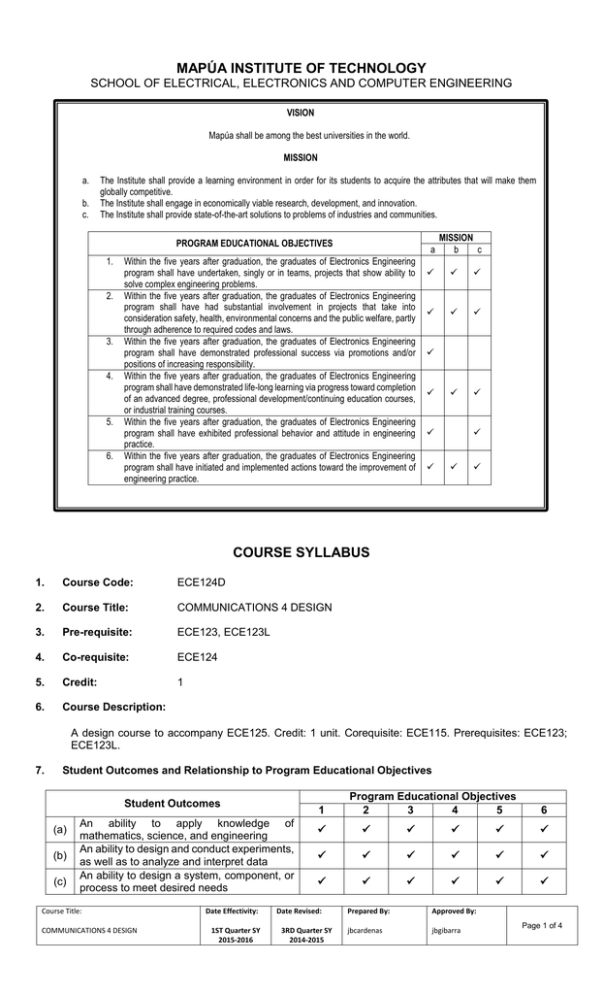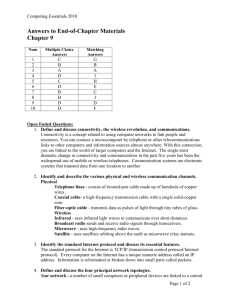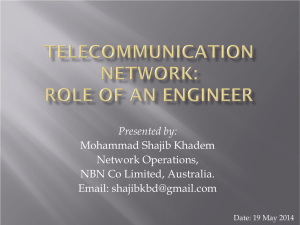
MAPÚA INSTITUTE OF TECHNOLOGY
SCHOOL OF ELECTRICAL, ELECTRONICS AND COMPUTER ENGINEERING
VISION
Mapúa shall be among the best universities in the world.
MISSION
a.
b.
c.
The Institute shall provide a learning environment in order for its students to acquire the attributes that will make them
globally competitive.
The Institute shall engage in economically viable research, development, and innovation.
The Institute shall provide state-of-the-art solutions to problems of industries and communities.
PROGRAM EDUCATIONAL OBJECTIVES
1.
2.
3.
4.
5.
6.
a
Within the five years after graduation, the graduates of Electronics Engineering
program shall have undertaken, singly or in teams, projects that show ability to
solve complex engineering problems.
Within the five years after graduation, the graduates of Electronics Engineering
program shall have had substantial involvement in projects that take into
consideration safety, health, environmental concerns and the public welfare, partly
through adherence to required codes and laws.
Within the five years after graduation, the graduates of Electronics Engineering
program shall have demonstrated professional success via promotions and/or
positions of increasing responsibility.
Within the five years after graduation, the graduates of Electronics Engineering
program shall have demonstrated life-long learning via progress toward completion
of an advanced degree, professional development/continuing education courses,
or industrial training courses.
Within the five years after graduation, the graduates of Electronics Engineering
program shall have exhibited professional behavior and attitude in engineering
practice.
Within the five years after graduation, the graduates of Electronics Engineering
program shall have initiated and implemented actions toward the improvement of
engineering practice.
MISSION
b
c
COURSE SYLLABUS
1.
Course Code:
ECE124D
2.
Course Title:
COMMUNICATIONS 4 DESIGN
3.
Pre-requisite:
ECE123, ECE123L
4.
Co-requisite:
ECE124
5.
Credit:
1
6.
Course Description:
A design course to accompany ECE125. Credit: 1 unit. Corequisite: ECE115. Prerequisites: ECE123;
ECE123L.
7.
Student Outcomes and Relationship to Program Educational Objectives
Student Outcomes
(a)
(b)
(c)
1
An ability to apply knowledge of
mathematics, science, and engineering
An ability to design and conduct experiments,
as well as to analyze and interpret data
An ability to design a system, component, or
process to meet desired needs
Course Title:
COMMUNICATIONS 4 DESIGN
Date Effectivity:
1ST Quarter SY
2015-2016
Program Educational Objectives
2
3
4
5
6
Date Revised:
3RD Quarter SY
2014-2015
Prepared By:
Approved By:
jbcardenas
jbgibarra
Page 1 of 4
(d)
(e)
(f)
(g)
(h)
(i)
(j)
(k)
(l)
8.
An ability to function on multi-disciplinary
teams
An ability to identify, formulate, and solve
engineering problems
An understanding of professional and ethical
responsibility
An ability to communicate effectively
The broad education necessary to
understand the impact of engineering
solutions in a global and societal context
A recognition of the need for, and an ability to
engage in life-long learning
A knowledge of contemporary issues
An ability to use the techniques, skills, and
modern engineering tools necessary for
engineering practice.
A knowledge and understanding of
engineering and management principles as a
member and leader in a team, to manage
projects
and
in
multidisciplinary
environments.
Course Outcomes (COs) and Relationship to Student Outcomes
Course Outcomes
After completing the course, the student must be able to:
1. Develop path profiles, selecting the best radio station
sites, utilizing topographical data, local conditions,
traditional and state of the art tools, and acceptable
engineering practice.
2. Compute for optimal link budget based on appropriate
technical specifications of commercially available
microwave equipment and materials.
3. Evaluate the different ways of improving the reliability of
a microwave system and then implement the best design
option.
4. Propose a price competative microwave system design
solution through written and oral presentations.
* Level: I- Introduced, R- Reinforced, D- Demonstrated
9.
a
b
c
Student Outcomes*
d e f g h i
R R R
R
R
R
R
R
k
l
I
R
R
R
j
R R
R
R R R
R
Course Coverage
Week
1-2
3-4
5
COURSE
OUTCOMES
CO1, CO2,
CO3, CO4
TOPIC
TLA
AT
Lecture
Introduction
CO1, CO2
Orientation, Radio Link Engineering,
Path Profiling, Transmission
Calculation, Equipment Design,
including reviewers on Earth Bulge,
Fresnel Zones, k and M profiles,
probability of outage, diversity and
protection schemes.
Off-school site activities
CO1, CO2,
CO3, CO4
Sourcing and data gathering,
preliminary path profiling using Topo
maps, Radio Mobile and Google
Earth.
Advance topic and focused
discussions
.
Course Title:
COMMUNICATIONS 4 DESIGN
Date Effectivity:
1ST Quarter SY
2015-2016
Date Revised:
3RD Quarter SY
2014-2015
Prepared By:
Approved By:
jbcardenas
jbgibarra
Page 2 of 4
Week
6-9
10
COURSE
OUTCOMES
CO2, CO3,
CO4
CO1, CO2,
CO3, CO4
11
CO1, CO2,
CO3, CO4
TOPIC
TLA
AT
off-school premise activities
Transmission Calculations; path, link
and equipment design; provision for
diversity reception; documentation
Defense and presentation
Capstone
In accordance to prescribed SPG and
OBE forms, generally presentation to
a panel comprised of ECE faculty
members
Review feedback assessment
.
10.
Lifelong-Learning Opportunities
11.
Students will be asked to to study on their own the use google earth and other software aids for site
selection process and radio mobile for path profiling
Students will be tasked to research on latest tools available that can be used in delivering the design
assignment
Students will be required to identify and then research the needed actual data, information and statistics
needed by the design assignment
Contribution of Course to Meeting the Professional Component
Radio Link Engineering, LOS Design Considerations - 90%
General Education, broad aspects of ECE - 10%
12.
Textbook
Electronic Communications Systems Fundamentals Through Advanced by Wayne Tomasi, Pearson
Prentice Hall, 2004
13.
Course Evaluation
Student performance will be rated based on the following:
Assessment Tasks
CO 1
CO 2
CO 3
CO 4
Weight
Capstone
Capstone
Capstone
Capstone
TOTAL
25%
25%
25%
25%
100%
Minimum Average for
Satisfactory
Performance
70.00%
70.00%
70.00%
70.00%
70.00%
The final grades will correspond to the weighted average scores shown below
13.1.
Average
Grade
Average
Grade
0 - 69.99
5.00
83.00 - 86.99
2.00
70.00 - 71.99
3.00
87.00 - 90.99
1.75
72.00 - 74.99
2.75
91.00 - 93.99
1.50
75.00 - 77.99
2.50
94.00 - 95.99
1.25
78.00 - 82.99
2.25
96.00 - 100.00
1.00
Other Course Policies
a. Grounds for failing course
Course Title:
COMMUNICATIONS 4 DESIGN
Date Effectivity:
1ST Quarter SY
2015-2016
Date Revised:
3RD Quarter SY
2014-2015
Prepared By:
Approved By:
jbcardenas
jbgibarra
Page 3 of 4
Aside from failing to meet the hurdle rate, other grounds for a failing grade are:
Any form of academic dishonesty
Submission of Design with spurious data or documentation
Failure to comply substantially to the design requirements
More than 30 % of the total number of meetings missed in a quartermaster; there shall be at least
3 class meetings prior to defense
Failure to submit Design (hard copy) with signed approval sheet on time
Failure to defend the Design with no earlier submitted valid excuse; for group work, all members
must be present during the defense
14.
Other References
14.1.
Books
Microwave Line of Sight Link Engineering by Angueira and Romo, Modern wireless communication, Haykin,
Simon, 2005
Introduction to wireless and mobile systems by Dharma P. Agrawal , Copyright 2006
MIMO system technology for wireless commun… by George Tsoulos 2006
The RF and microwave handbook by Mike Golio copyright2007
Optical waveguides by Maria Calvo copyright 2006
RF/microwave interaction with biological tissues by Vorst, Andre Vander, 2006
Roaming in wireless networks by Siddiqui, Shahid K.
Modern wireless communication, Haykin, Simon, 2005
Introduction to wireless and mobile systems by Dharma P. Agrawal , Copyright 2006
MIMO system technology for wireless commun… by George Tsoulos 2006
The RF and microwave handbook by Mike Golio copyright2007
Optical waveguides by Maria Calvo copyright 2006
RF/microwave interaction with biological tissues by Vorst, Andre Vander, 2006
Roaming in wireless networks by Siddiqui, Shahid K.
Wireless Guide to Wireless Communications: networking by Olenewa, 2007
Fundamentals of WIMAX understanding broadband wireless by Andrews, J., 2007
Fiber Optics Essentials by Decusatis, 2006
Satellite ommunications, 4th ed. By Roddy, 2006
Advanced wireless communications by Glisic, Save, 2004
Nonlinear Microwave circuit design by Giannini, Franco, 2004
Wi-Fi handbook : building 802.11b wireless by Ohrtman, Frank, 2003
Fiber optics handbook by Bass, Michael, 2002
Wireless communication technology by Blake, Roy, 2001
Complete wireless design by Sayre, Cotter W, 2001
Wireless telecommunications networking with ANSI-41. 2nd ed. By Snyder, Randall A, 2001
High frequency and microwave engineering w/ CD. By Da Silva, E, 2001
Microstrip filters for RF/microwave applications by Hong, Jia-Shen G, 2001
Designing wireless information services by Hjelm, Johan, 2000
Optical fiber communications w/ CD. 3rd ed. By Keiser, Gerd, 2000
Microwave engineering by Das, Annapurma, 2000
RF/Microwave circuit design for wireless applications by Rohde, Ulrich, 2000
Modern electronic communications. 6th ed. By Miller, Gary M, 1999
Satellite communications systems. 2nd ed. By Richharia, M, 1999
Radio-frequency & microwave communication circuits by Misra, Devendra, 1999
15.
a.
b.
c.
d.
16.
Course Materials
Course goals and instructional objectives.
Course information sheet..
Topographical maps/databases and engineering design standards.
Samples of designs from students.
15.1. e. Catalogs and brochures of microwave equipment from different equipment vendors.
Committee Members
BALBIN, JESSIE (RODIEL)
CARDENAS, JOSE (B)
SUELTO, HILARIO (B)
Course Title:
COMMUNICATIONS 4 DESIGN
Date Effectivity:
1ST Quarter SY
2015-2016
Date Revised:
3RD Quarter SY
2014-2015
Prepared By:
Approved By:
jbcardenas
jbgibarra
Page 4 of 4








